Samsung Announces the Galaxy S 6 and S 6 Edge
by Joshua Ho on March 1, 2015 12:30 PM EST- Posted in
- Smartphones
- Samsung
- Mobile
- SoCs
- Galaxy S6
- Exynos 7420
- Galaxy S6 Edge
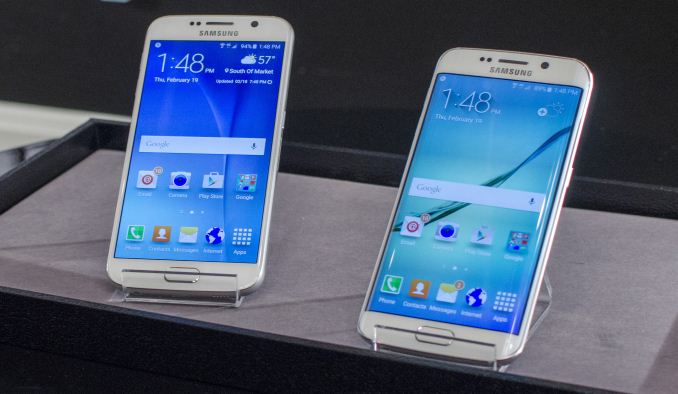
In recent times, Samsung has seen the erosion of their dominance in the Android ecosystem. The reasons for why this is are many, but at least some of the criticism has been focused on the products themselves. At the high end, many criticisms have been leveled at the industrial and material design of Galaxy S and Note devices, and outside of the hardware itself, TouchWiz has received a great deal of criticism for performance issues and poor design. This brings us to the Galaxy S 6 and S 6 edge, which represents a fundamental shift in the way Samsung approaches the way their phones are made and designed. While we’ve seen these changes in the form of the Galaxy A line and the Galaxy Note 4, the Galaxy S6 represents the first phone that has been made from the ground up with a focus on industrial and material design.
This focus on design is immediately apparent as the Galaxy S 6 is the first Galaxy S phone with a unibody design. There are no visible seams or screws, and there is no apparent gap between the glass back and the metal frame of the phone. In person, the design of the Galaxy S 6 is really quite shocking when compared to the Galaxy S 5 or any previous Galaxy S device. It seems that there has been a great deal of thought and care put into each aspect of the device. The metal frame is far from a simple curve, and is somewhat rounded along the top and bottom, but flattens out along the sides for better grip. The edges of the frame are slightly chamfered as well, in order to make edge swipes off of the display smooth and natural. The display is centered on the device, with symmetrical top and bottom bezels, and thin side bezels. The back cover is clean, with a glass back that has little in the way of distractions outside of the camera, LED flash module, and a Samsung logo. Overall, the Galaxy S6 has been a massive departure from everything else that has come before it.
While the design is one aspect of the Galaxy S 6, the specs are another. While it’s often popular to repeat that specs don’t matter, they represent the foundation for the entire user experience. To start, we’ve placed the usual spec sheet below to get the basics down.
| Samsung Galaxy S5 | Samsung Galaxy S6 | Samsung Galaxy S6 Edge | |
| SoC | MSM8974ACv3 2.45 GHz Snapdragon 801 | Exynos 7420 2.1/1.5GHz A57/A53 | Exynos 7420 2.1/1.5GHz A57/A53 |
| RAM/NAND | 2GB LPDDR3 16/32GB NAND + microSD |
3GB LPDDR4-1552 32/64/128GB NAND |
3GB LPDDR4-1552 32/64/128GB NAND |
| Display | 5.1” 1080p SAMOLED HD | 5.1” 1440p SAMOLED | 5.1” 1440p SAMOLED, Dual Edge |
| Network | 2G / 3G / 4G LTE (Qualcomm MDM9x25 UE Category 4 LTE) | 2G / 3G / 4G LTE (Category 6 LTE) | 2G / 3G / 4G LTE (Category 6 LTE) |
| Dimensions | 142 x 72.5 x 8.1 mm, 145 grams | 143.4 x 70.5 x 6.8mm max, 138 grams | 142.1 x 70.1 x 7.0mm max, 132 grams |
| Camera | 16MP (5132 x 2988) Rear Facing with 1.12 µm pixels, 1/2.6" CMOS size, 31 mm (35mm effective), f/2.2 2MP Front Facing |
16MP (5132 x 2988) Rear Facing w/ OIS, f/1.9, object tracking AF 5MP Front Facing, f/1.9 |
16MP (5132 x 2988) Rear Facing w/ OIS, f/1.9, object tracking AF 5MP Front Facing, f/1.9 |
| Battery | 2800 mAh (10.78 Whr) | 2550 mAh (9.81 Whr) | 2600 mAh (10.01 Whr) |
| OS | Android 4.4 w/TouchWiz | Android 5 (64-bit) w/TouchWiz | Android 5 (64-bit) w/TouchWiz |
| Connectivity | 802.11a/b/g/n/ac 2x2 + BT 4.0, USB3.0, GPS/GNSS, MHL, DLNA, NFC | 2x2 802.11a/b/g/n/ac + BT 4.1, USB2.0, GPS/GNSS, NFC | 2x2 802.11a/b/g/n/ac + BT 4.1, USB2.0, GPS/GNSS, NFC |
| Wireless Charging | N/A | WPC 1.1 (4.6W) & PMA 1.0 (4.2W) | WPC 1.1 (4.6W) & PMA 1.0 (4.2W) |
| Fingerprint Sensor | Swipe | Touch | Touch |
| SIM Size | MicroSIM | NanoSIM | NanoSIM |
As one can see, there are a few key highlights of note in the Galaxy S 6. The Exynos 7420 SoC is the first SoC to be built on Samsung’s 14nm FinFET process. While this isn’t comparable to Intel’s 14nm process due to the use of a 20nm metal interconnect, there are some density improvements in areas that aren’t gated by interconnect pitch. While transistors are an area where we can see significant improvements to clock speed and power consumption, the metal interconnects can influence performance as well due to power dissipated by resistance in the interconnects, in addition to limitations on clock speed due to RC delay. This means that Intel continues to hold a significant process lead, as reducing interconnect pitch is exponentially more difficult past the 20nm node as resistance and capacitance issues increase dramatically. On the GPU side of things for example, the voltage drop is huge, showing an average of -200mV up to -300mV decrease at the 700MHz state. Overall, this move to 14nm should dramatically reduce power consumption as the effect of leakage is nearly eliminated.
Outside of process node, the Exynos 7420 is a rather standard big.LITTLE SoC, with four Cortex A57s at 2.1 GHz and four Cortex A53s at 1.5 GHz. However, the Exynos 7420 represents the first Exynos SoC to have full AArch64 support in software, unlike the Exynos 5433. The GPU is upgraded to a Mali T760MP8 solution running at up to 772MHz as the top frequency and 700MHz as the secondary maximum state, a huge improvement as the voltages top out at 825mV. We should be seeing very impressive battery efficiency improvements due to the 14nm process. The SoC supports LPDRR4 running at 1552MHz, and Samsung has equipped the Galaxy S6 with a UFS 2.0 storage solution. It remains to be seen whether this is a major point of differentiation this year, but in practice it seems that the Galaxy S 6 was smooth. Areas like the multitasking interface were noticeably faster to open and close, but there were still some scenarios where I saw some slight frame drops which is likely due to the pre-release software.
Another major area of focus for Samsung for the S6 was refining the camera. While the sensor remains the same Sony sensor that we saw in the Galaxy Note 4, Samsung has improved the optics to have a maximum aperture size of f/1.9 compared to the f/2.2 that we saw with the Galaxy S5 in addition to an IR sensor in order to improve white balance detection. OIS is also introduced to the Galaxy S lineup for this generation, and in practice the stabilization is as effective as the Galaxy Note 4. Samsung strongly prioritized shooting speed and general camera speed with this generation, as they introduced object tracking AF, a double tap camera gesture, and further refinement of the PDAF system in order to make the camera experience much better than before. The object tracking AF is similar to what we've seen on phones like the Huawei Ascend Mate 7 before, but double-tapping the home button to wake up the camera was almost instant compared to pretty much any other method I've seen before. The long start-up time that I saw with the Galaxy S5's camera application has also disappeared for the most part, and in general places like the gallery and camera application are much faster than before. The front-facing camera is also a 5MP camera, which represents an upgrade over the Galaxy Note 4 but shares a f/1.9 aperture. Unfortunately, I was unable to really test the camera at all but it should be at reasonable improvement over the Galaxy Note 4's camera.
For the S6 Samsung has also improved on the AMOLED display, both in quality and pixel density/resolution. Although we have relatively little detail on this, Samsung claims 600 nit luminance, up from their claimed 500 nits from the Galaxy S5 which means that this isn't the same panel as what we saw in the GS5 LTE-A. In addition, Samsung has included wireless charging support for both WPC1.1 and PMA 1.0 standards built into every Galaxy S6. The new fingerprint sensor is also amazing in comparison the experience with the Galaxy S5, and works about as well as Apple's TouchID system. Samsung is bundling this with Samsung Pay, which allows for payments with the fingerprint sensor for authentication and while not available at launch, Samsung will also support legacy magstripe terminals for mobile payments on the Galaxy S6. Samsung has also improved the speaker dramatically from the Galaxy S5, and it should have significantly improved sound quality and volume, in addition to the improved placement on the bottom of the phone. TouchWiz seems to remain relatively similar in design, but there's a big reduction in the number of pre-installed applications. There are some applications preinstalled by Microsoft such as OneNote, OneDrive, and Skype, but in general there's almost no bloat to speak of.
Overall, the Galaxy S6 seems to be quite promising. Although the design seems to be somewhat inspired by other devices on the market, the industrial and material design is a massive step forward from everything else we've seen from Samsung before. In general, it seems that Samsung has managed to put together a device that can truly compete with devices like the One M9 and iPhone 6 in every aspect, although it'll take a full review to really get a good idea for how it shapes up against the competition. The Samsung Galaxy S6 and S6 edge will be available globally starting April 10th with 32, 64, and 128 GB storage SKUs. The Galaxy S6 and S6 edge will both have white, black, and gold colors available, but the blue color will be limited to the Galaxy S6 and the emerald green will be limited to the Galaxy S6 Edge.


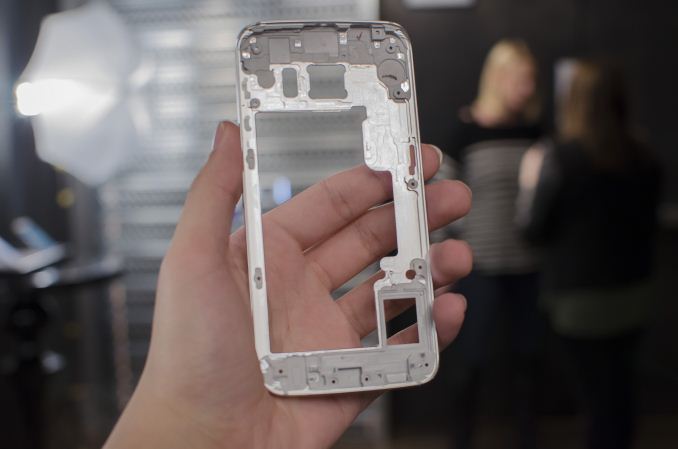


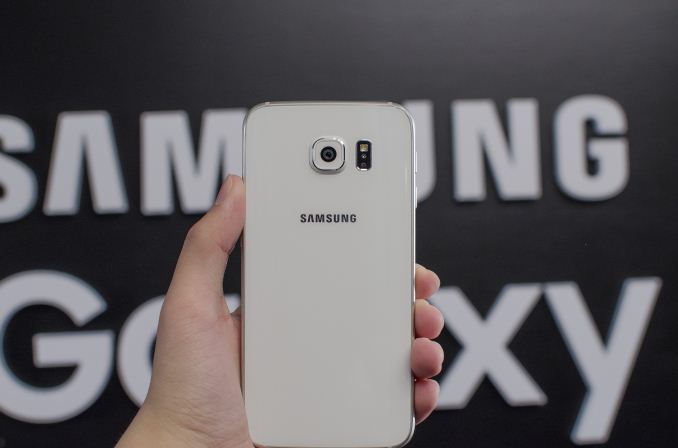
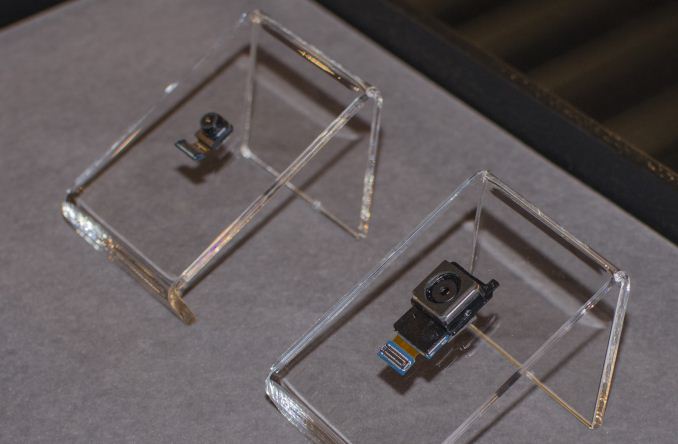
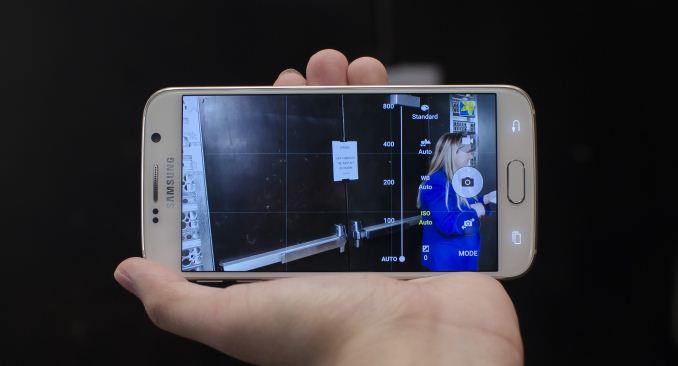
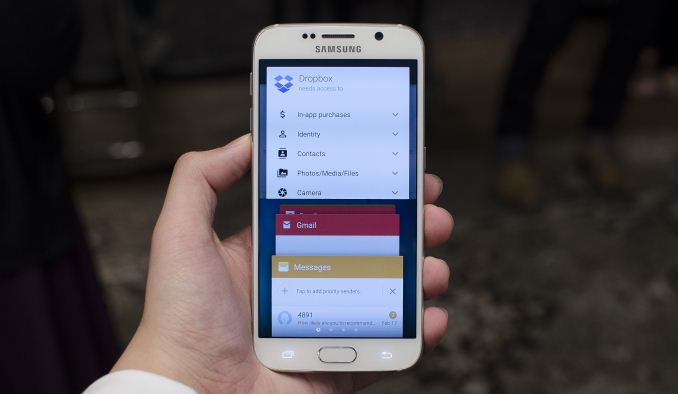
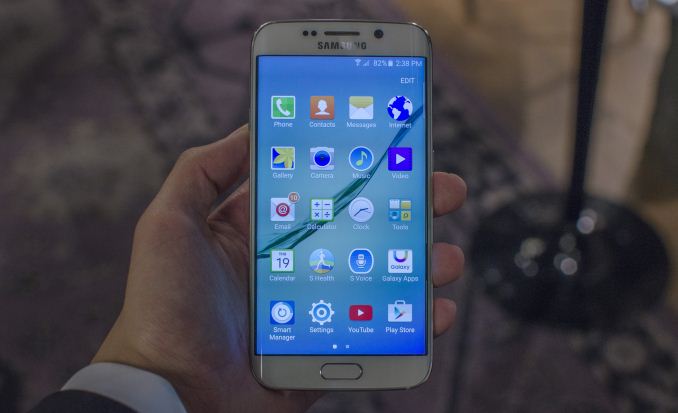
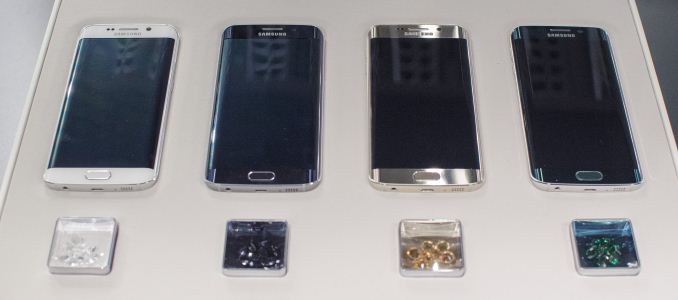
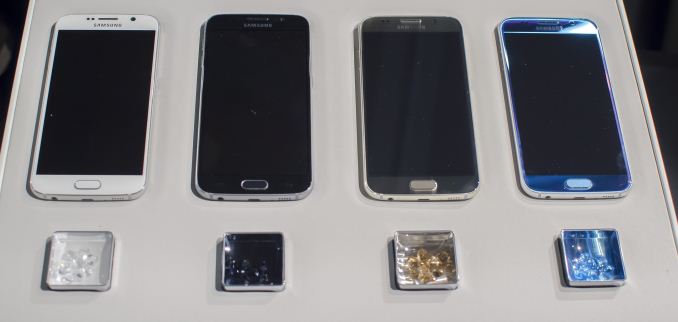














206 Comments
View All Comments
robertkoa - Thursday, March 5, 2015 - link
Exactly MANY phones are too quiet on ringtones to hear in a Restaurant, Mall, Office.sonny73n - Friday, March 6, 2015 - link
"If you truly need better fidelity, bluetooth, headphones, or stop cryin'."WHAT!!!??? You're a real jerk accusing someone for crying and telling him to stop.
If I pay a premium price for a flagship device, I want it to have better sound than the previous models. Have you ever played games with with sound thru Bluetooth headphones or Bluetooth speakers? The sound thru Bluetooth would get delayed and there's no way to sync it. And what if I just record a video (say in a party) and want to review it with the people there right after? Are those good enough reasons for better speaker sound? Some people (myself included) doesn't like to wear earphone/headphone especially wired ones. Anyway, it doesn't matter these S6s have good sound or not, I don't care because I'm not interested in these ugly overpriced junks.
BTW if you can't take any constructive criticism which wasn't even meant for you in the first place, move on to the one that you like. Stop being rude.
anubis44 - Monday, March 9, 2015 - link
If you want truly decent sound quality in a smart phone, Blackberry can't be beat for that. It'll also run Android apps, too, and has the best messaging/inbox software in the business.jt122333221 - Sunday, March 1, 2015 - link
So, the reason I use a device with a front-facing speaker is so I don't need to carry around a portable Bluetooth speaker or headphones everywhere I go. In the case that I want to show something to friends or want to watch a video and actually hear it, I have a device with front facing speakers that are powerful enough to make sure sound is heard in most settings (currently it's a Nexus 6, previously Xperia Z3 and HTC One M7).Both of your points to refute front-facing speakers are "carry around a speaker", which is why people want front-facing speakers - so they don't have to carry around a speaker/headphones to hear their device.
III-V - Monday, March 2, 2015 - link
Thanks for pointing that out.I hadn't really understood the value of having a good speaker on a phone -- I mean, there are a million more important things on my laundry list. But when you put it that way -- that it means you don't need a bluetooth speaker (in most cases) -- I definitely see the value in it.
boslink - Tuesday, March 3, 2015 - link
My dear god!!Because of people like you we lost battery and SD card port.
Now you want front speakers
Go buy HTC or Iphone
Its shame Samsung listen to people that never ever buy their phones and with that they lose buyers like I am that actually BUY their hones (1 S4 and 3 S5 i bought unlocked).
I was waiting S6 to replace my S4 but . . . .
No micro SD no buyer in my case. It is a deal breaker for me
So Samsung lost me and he never had you. Smart move i must say
flyingpants1 - Saturday, March 7, 2015 - link
Front speakers are very important and useful. So is wireless charging. Nobody wants to fart around with microSD cards anymore.perpetualdark - Monday, March 9, 2015 - link
wireless charging is great... in theory. In practice it is worthless. I tried the S5 just so I could do wireless charging. Thing is, as soon as it finishes, it will turn on and alert you. No way to turn that off without rooting the phone, and I don't buy brand new top of the line equipment so I can hack it and redo what should be done in the first place. So at night, after about 3 hours of charging, the phone comes on, lighting up my room like the sun came up, then beeping at me. So I turn it to vibrate, but then when this happens it vibrates "waa waa". I need my phone on to some extent in case I get an emergency call from my kids. (I tried turning it off, and sure enough, 4 days later, worst case scenario happened, I missed an emergency phone call).You might think one vibrate tone isn't bad, but you see, Samsung decided if it finishes charging to stop charging completely. So a minute passes, and it decides it now needs to charge again, so once again it comes on and beeps or vibrates. This continues, every 60-90 seconds until you take it off the charging pad. Since the phone has to face up, you can't get around the screen lighting up your room either.
As if that weren't enough, you have to have it centered on the pad. I don't mean close, I mean dead center. If it is off by more than about a half centimeter, the whole cycle of turning on and beeping/vibrating will start up, about 30 seconds apart.
So I would say that while wireless is a cool idea, expecting it to be a selling feature that is actually useful is really pushing it.
dawheat - Sunday, March 1, 2015 - link
Why so? AMOLEDs don't necessary draw more power as the resolution goes up - the Note 4 1440p screen drew 14% less power than the Note 3 1080p. It's not like LCDs (e.g. G3).Most people I know don't do 3D games on their phone so none of this matters to them regardless, but really the only issue is load on the GPU when gaming. If the 14nm SOC ends up being able to handle it without too much power draw, then what's the problem? Let technology advance in every area - you get a sharper, brighter, more accurate, and efficient screen. How's that a bad thing?
DERSS - Monday, March 2, 2015 - link
With OLED phones power consumption of 1440p versus 1080p is mostly matter of SoC, not screen. A lot more data to process and calculate. Hence bigger power consumption and lower frame rates in graphic applications such as games.However, since OLED screens do not have normal RGB pixels 1440p helps with making picture quality better. 1440p in LCD would be definitely excessive, but in OLED it is debatable.